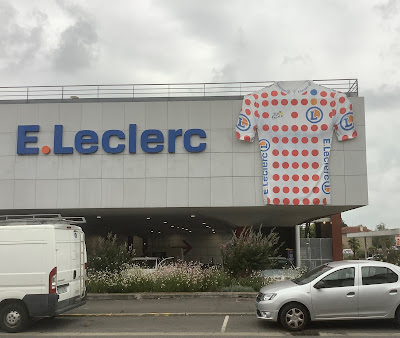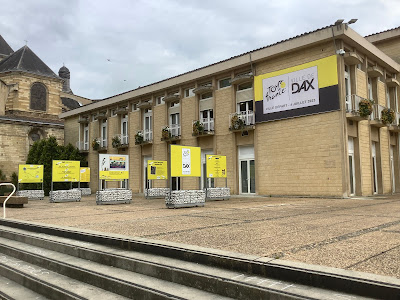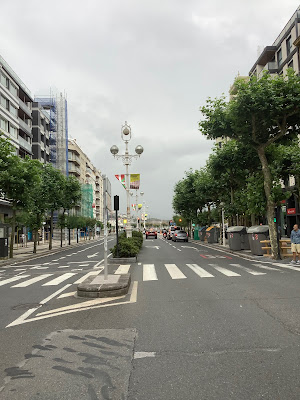Two of the last three Ville Étapes I scouted in France before crossing into Spain had a strong connection with a Tour luminary from year’s past—Luis Ocana with Mont-de-Marsan and André Darrigade with Dax.
Ocana was a Spanish rider who won the 1973 Tour. His family moved from Spain to Mont-de-Marsan when he was twelve years old and was where he began his racing career. He was a rival of Merckx and was so often thwarted by him he named his dog Merckx so he could order him around. He is one of several Tour winners to take his own life. The local club he rode for is still going strong and honors his Tour win with a “1973” on its jersey. The city has just built a velodrome that will have its grand opening the day the Tour comes to town for the stage seven départ and will be anointed the Ocana velodrome.
Dax too will serve as a Ville Départ and will pass by a grand statue of Darrigade in a roundabout a mile-and-a-half from the city center in the small neighboring town where he was born. Darrigade was considered The Tour’s greatest sprinter until Mark Cavendish came along and surpassed his record of twenty-two sprint wins accumulated in the ‘50s and ‘60s. He wore the Yellow Jersey for nineteen stages, more than Cavendish, and won the points competition in 1959 and 1961. His palmares also include a world championship, as does Cavendish’s.
Cavendish has exceeded his wins by twelve and is tied with Merckx for the most career Tour stage wins. He’s hoping to surpass Merckx this year in his final Tour, as he will be retiring at the end of the year. The first sprint stage of this year’s race comes the day before the Dax stage on stage three finishing in Bayonne. It would be fitting for Cavendish to win that stage and set out the next day from the hometown of the Tour’s second most illustrious sprinter.
Darrigade was such a popular French figure that recent French Nobel prize winner for literature, Annie Ernaux, mentions him in “The Years,” a memoir of her youth. Janina alerted me to this most telling passage, demonstrating the prominence of The Tour in French culture, fully capturing the attention of a young French girl: “July was the Tour de France, which we followed on the radio, cutting photos from the papers (Geminiana, Darrigade and Coppi) and pasting them in albums.”
Besides the statue, Dax has named its sports complex for Darrigade. His Peugeot bike, complete with toe clips, hung from the ceiling in one of the buildings along with three of his team jerseys.
He was also featured on one of the eight Tour-related placards mounted in front of the city hall. Two of them listed the six previous times Dax had served as a Ville Étape and who won the stage and who was wearing the Yellow Jersey at the time. Armstrong was in Yellow on two of the stages in 2000 and 2003.
My final miles in France were along the hectic and overdeveloped coast, not fun cycling at all. It didn’t let up when I crossed into Spain, but I felt I could celebrate, completing my long ride from Paris. I still had nearly one hundred miles to Bilbao and the start of The Tour, but it was as if I had made it. The pressure was off. I could relax knowing I had a day-and-a-half to make it. It had been a long hard push putting in seven or eight hours a day on the bike for over a week, usually riding until nine pm to insure I’d arrive for the start.
My legs were fine largely thanks to a nearly four thousand mile spring ride and some hard rides with the local club. They even felt as if they were getting stronger as the ride progressed handling the climbs with greater ease than at the start. The first two or three days of The Tour they’ll actually get a little respite, as I won’t be riding the stages in their entirety, as they wind about and criss cross each other enabling me to reach stage finishes early and sit and watch the action on the Big Screen with dozens of others.
I will greatly welcome the course markers, as getting from the border to the large coastal city San Sebastián, which the peloton will pass through on the second and third stages, was an ordeal having to check my GPS all too often. I was lucky to come upon a road crew that could direct me once when I reached a superhighway forbidding bikes without offering an alternative as do the French.
Once I got through San Sebastián I got on highway 634 that would be my route for eighty miles to Bilboa and could forgo the GPS. It was late in the evening when I finally escaped San Sebastián and had the challenge to find a place to camp. My first two attempts were foiled by soggy ground and thick prickly bushes. At last I came upon a steep overgrown dirt road that led to a string of power lines. It was perfect and I had another night of superlative camping.











No comments:
Post a Comment